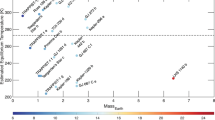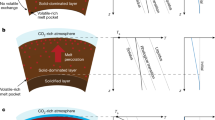Abstract
The ice-rich surface of the jovian satellite Europa is sparsely cratered, suggesting that this moon might be geologically active today1. Moreover, models of the satellite's interior indicate that tidal interactions with Jupiter might produce enough heat to maintain a subsurface liquid water layer2,3,4,5. But the mechanisms of interior heat loss and resurfacing are currently unclear, as is the question of whether Europa has (or had at one time) a liquid water ocean6,7. Here we report on the morphology and geological interpretation of distinct surface features—pits, domes and spots—discovered in high-resolution images of Europa obtained by the Galileo spacecraft. The features are interpreted as the surface manifestation of diapirs, relatively warm localized ice masses that have risen buoyantly through the subsurface. We find that the formation of the features can be explained by thermally induced solid-state convection within an ice shell, possibly overlying a liquid water layer. Our results are consistent with the possibility that Europa has a liquid water ocean beneath a surface layer of ice, but further tests and observations are needed to demonstrate this conclusively.
This is a preview of subscription content, access via your institution
Access options
Subscribe to this journal
Receive 51 print issues and online access
$199.00 per year
only $3.90 per issue
Buy this article
- Purchase on Springer Link
- Instant access to full article PDF
Prices may be subject to local taxes which are calculated during checkout


Similar content being viewed by others
References
Carr, M. H.et al. Evidence for a subsurface ocean on Europa. Nature 391, 363–365 (1998).
Cassen, P. M., Peale, S. J. & Reynolds, R. T. in Satellites of Jupiter (ed. Morrison, D.) 93–128 (Univ. Arizona Press, Tucson, 1982).
Squyres, S. W., Reynolds, R. T., Cassen, P. & Peale, S. J. Liquid water and active resurfacing on Europa. Nature 301, 225–226 (1983).
Ross, M. & Schubert, G. Tidal heating in an internal ocean model of Europa. Nature 325, 133–134 (1987).
Ojakangas, G. W. & Stevensonn, D. J. Thermal state of an ice shell on Europa. Icarus 81, 220–241 (1989).
Lucchitta, B. K. & Soderblomm, L. A. in Satellites of Jupiter (ed. Morrison, D.) 521–555 (Univ. Arizona Press, Tucson, 1982).
Carr, M. H. et al. The Galileo Imaging Team plan for observing the satellites of Jupiter. J. Geophys. Res. 100, 18935–18955 (1995).
Greeley, R.et al. Europa triple bands: Galileo images. Lunar Planet. Sci. Conf. Abstr. 28, 455–456 (1997).
Kargel, J. S. Brine volcanism and the interior structures of asteroids and icy satellites. Icarus 94, 368–390 (1991).
Jenyon, M. K. Salt Tectonics (Elsevier, New York, 1986).
O'Brien, G. D. Mem. Am. Assoc. Petrol. Geol. 8, 1–9 (1968).
Schenk, P. & Jackson, M. P. A. Diapirism on Triton: A record of crustal layering and instability. Geology 21, 299–302 (1993).
Schubert, G., Spohn, T. & Reynoldss, R. T. in Satellites (eds Burns, J. A. & Matthews, M. S.) 224–292 (Univ. Arizona Press, Tucson, 1986).
Reynolds, R. T. & Cassen, P. M. On the internal structure of the major satellites of the outer planets. Geophys. Res. Lett. 6, 121–124 (1979).
Goldsby, D. L. & Kohlstedt, D. L. Flow of ice I by dislocation, grain boundary sliding, and diffusion processes. Lunar Planet. Sci. Conf. Abstr. 28, 429–430 (1997).
Goldsby, D. L. & Kohlstedt, D. L. Grain boundary sliding in fine-grained ice I. Scripta Mat. 37, 1399–1406 (1997).
Stengel, K. C., Oliver, D. S. & Booker, J. R. Onset of convection in a variable viscosity fluid. J. Fluid Mech. 120, 411–431 (1982).
Mueller, S. & McKinnon, W. B. Three-layered models of Ganymede and Callisto: Compositions, structures, and aspects of evolution. Icarus 76, 437–464 (1988).
Hobbs, P. V. Ice Physics (Clarendon, Oxford, 1974).
Squyres, S. W. & Croft, S. K. in Satellites (eds Burns, J. A. & Matthews, M. S.) 293–341 (Univ. Arizona Press, Tucson, 1986).
Greenberg, R., Geissler, P., Pappalardo, R. & Galileo Imagging Team. Long term and ‘diurnal’ tidal stresses on Europa. Lunar Planet. Sci. Conf. Abstr. 28, 457–458 (1997).
Geissler, P. E.et al. Evidence for non-synchronous rotation of Europa Nature 391, 368–370 (1998).
Ojakangas, G. W. & Stevenson, D. J. Polar wander of an ice shell on Europa. Icarus 81, 242–270 (1989).
Geissler, P. E., Phillips, C. & Denk, T. in Proc. Workshop on Remote Sensing of Planetary Ices: Earth and Other Solid Bodies 8.5 (1997).
Pappalardo, R.et al. Deformation and properties of Europa's lithosphere. Eos 78, S203 (1996).
Williams, K. K.et al. Estimates of ice thickness on Europa. Eos 78, F415–F416 (1997).
McKinnon, W. B. Convective instabilities in Europa's floating ice shell. Bull. Am. Astron. Soc. 29, 984 (1997).
Anderson, J. D.et al. Europa's differentiated internal structure: Inferences from two Galileo encounters. Science 276, 1236–1239 (1997).
Durham, W. B., Kirby, S. H. & Stern, L. A. Effects of dispersed particulates on the rheology of water ice at planetary conditions. J. Geophys. Res. 97, 20883–20897 (1992).
Acknowledgements
We thank W. McKinnon and N. Sleep for reviews; N. Sherman, L. Prockter and G. Collins for their contributions; and J. Kaufman, K. Magee and K. Klaasen for their efforts in acquisition of the E6 Europa imaging data. This work was supported by NASA's Galileo Project.
Author information
Authors and Affiliations
Corresponding author
Rights and permissions
About this article
Cite this article
Pappalardo, R., Head, J., Greeley, R. et al. Geological evidence for solid-state convection in Europa's ice shell. Nature 391, 365–368 (1998). https://doi.org/10.1038/34862
Received:
Accepted:
Issue Date:
DOI: https://doi.org/10.1038/34862
This article is cited by
Investigating Europa’s Habitability with the Europa Clipper
Space Science Reviews (2023)
Double ridge formation over shallow water sills on Jupiter’s moon Europa
Nature Communications (2022)
Grain growth inhibited during grain size-sensitive creep in polycrystalline ice: an energy dissipation-rate perspective
Physics and Chemistry of Minerals (2022)
Science Goals and Mission Objectives for the Future Exploration of Ice Giants Systems: A Horizon 2061 Perspective
Space Science Reviews (2021)
Ice-Ocean Exchange Processes in the Jovian and Saturnian Satellites
Space Science Reviews (2020)
Comments
By submitting a comment you agree to abide by our Terms and Community Guidelines. If you find something abusive or that does not comply with our terms or guidelines please flag it as inappropriate.



